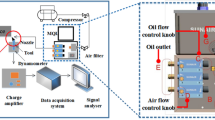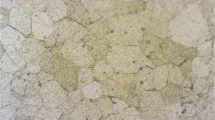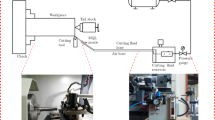Abstract
In this study, turning of titanium (Ti-6Al-4V) alloy under four different environments as dry, vegetable oil under minimum quantity lubrication (MQL), texture on the rake face filled with graphene particles, and graphene-mixed vegetable oil under nanoparticle-based minimum quantity lubrication (NMQL) with textured carbide tools is investigated. Results shows that maximum tool life, lower cutting forces, and minimum cutting temperature generated are with NMQL followed by MQL, texture filled with graphene, and dry turning. The tool life under NMQL is improved by 178 to 190%, main cutting force minimized by 36 to 40%, and cutting temperature reduced by 31 to 42% as compared with dry condition at various cutting speeds. The best turning performance is achieved under NMQL which is mainly due to higher thermal conductivity of MQL fluid mixture and shearing action imparted by graphene on different contact surfaces of tool. Further, the phenomena of improved thermal conductivity and shearing action imparted by graphene are explained by using transient hot-wire/SEM/Raman spectroscopy in this study. Finally, it is concluded that graphene has potential to act as lubricant/coolant in turning processes.












Similar content being viewed by others
Abbreviations
- MQL:
-
Minimum quantity lubrication
- NMQL:
-
Nanoparticle-based minimum quantity lubrication
- F x :
-
Axial thrust force (N)
- F y :
-
Radial thrust force (N)
- Fz :
-
Main cutting force (N)
- VBmax :
-
Maximum flank wear (μm)
- V c :
-
Cutting speed (m/min)
- f :
-
Feed (mm/rev)
- a p :
-
Depth of cut (mm)
- r e :
-
Nose radius (mm)
- HRC:
-
Rockwell hardness on C scale
- SEM:
-
Scanning electron microscope
- ASTM:
-
American Society for Testing and Materials
- ISO:
-
International Organization for Standardization
- L/D:
-
Length to diameter ratio
- T1:
-
Dry textured tool
- T2:
-
Textured tool with canola oil as MQL based
- T3:
-
Textured tool filled with graphene
- T4:
-
Textured tool with graphene mixed in canola oil as NMQL fluid
References
Mia M, Dhar NR (2018) Effects of duplex jets high-pressure coolant on machining temperature and machinability of Ti-6Al-4V superalloy. J Mater Process Technol 252:688–696. https://doi.org/10.1016/j.jmatprotec.2017.10.040
Maruda RW, Krolczyk GM, Wojciechowski S, Zak K, Habrat W, Nieslony P (2018) Effects of extreme pressure and anti-wear additives on surface topography and tool wear during MQCL turning of AISI 1045 steel. 32:1585–1591. https://doi.org/10.1007/s12206-018-0313-7
Krolczyk GM, Maruda RW, Krolczyk JB, Wojciechowski S, Mia M, Nieslony P, Budzik G (2019) Ecological trends in machining as a key factor in sustainable production–A review. JClean Prod 218:601–615
Gupta MK, Sood P (2017) Machining comparison of aerospace materials considering minimum quantity cutting fluid: a clean and green approach. Proc Inst Mech Eng C J Mech Eng Sci 231:1445–1464. https://doi.org/10.1177/0954406216684158
Dureja JS, Singh R, Singh T, Singh P, Dogra M, Bhatti MS (2015) Performance evaluation of coated carbide tool in machining of stainless steel (AISI 202) under minimum quantity lubrication (MQL). Int J Precis Eng Manuf Technol 2:123–129. https://doi.org/10.1007/s40684-015-0016-9
Sharma N, Gupta K (2019) Influence of coated and uncoated carbide tools on tool wear and surface quality during dry machining of stainless steel 304. Mater Res Express 6:086585. https://doi.org/10.1088/2053-1591/ab1e59
Sen B, Hussain SAI, Mia M, Mandal UK, Mondal SP (2019) Selection of an ideal MQL-assisted milling condition: an NSGA-II-coupled TOPSIS approach for improving machinability of inconel 690. Int J Adv Manuf Technol 103:1811–1829. https://doi.org/10.1007/s00170-019-03620-6
Singh T, Singh P, Dureja JS, Dogra M, Singh H, Bhatti MS (2016) A review of near dry machining/minimum quantity lubrication machining of difficult to machine alloys. Int J Mach Mach Mater 18:213–251. https://doi.org/10.1504/IJMMM.2016.076276
Dogra M, Sharma VS, Dureja JS, Gill SS (2018) Environment-friendly technological advancements to enhance the sustainability in surface grinding- a review. J Clean Prod 197:218–231. https://doi.org/10.1016/j.jclepro.2018.05.280
Oliveira D, Carvalho A, Rosa L, Jackson MJ, Machado ÁR (2019) Performance evaluation of vegetable-based cutting fluids in turning of AISI 1050 steel. Int J Adv Manuf Technol 103:1603–1619. https://doi.org/10.1007/s00170-019-03636-y
Dong L, Li C, Bai X, Zhai M, Qi Q, Yin Q, Lv X, Li L (2019) Analysis of the cooling performance of Ti – 6Al – 4V in minimum quantity lubricant milling with different nanoparticles. Int J Adv Manuf Technol 103:2197–2206
Pereira O, Alfonso JEM, Rodriguez A, Calleja A, Valdivielso AF, López de Lacalle LN (2017) Sustainability analysis of lubricant oils for minimum quantity lubrication based on their tribo-rheological performance. J Clean Prod 164:1419–1429. https://doi.org/10.1016/j.jclepro.2017.07.078
Rapeti P, Pasam VK, Gurram KMR, Revuru RS (2018) Performance evaluation of vegetable oil based nano cutting fluids in machining using grey relational analysis-a step towards sustainable manufacturing. J Clean Prod 172:2862–2875. https://doi.org/10.1016/j.jclepro.2017.11.127
Bai X, Li C, Dong L, Yin Q (2019) Experimental evaluation of the lubrication performances of different nanofluids for minimum quantity lubrication ( MQL ) in milling Ti-6Al-4V. Int J Adv Manuf Technol 101:2621–2632
Su Y, Gong L, Li B, Liu Z, Chen D (2016) Performance evaluation of nanofluid MQL with vegetable-based oil and ester oil as base fluids in turning. Int J Adv Manuf Technol 83:2083–2089. https://doi.org/10.1007/s00170-015-7730-x
Yi S, Li N, Solanki S, Mo J, Ding S (2019) Effects of graphene oxide nano fluids on cutting temperature and force in machining Ti-6Al-4V. Int J Adv Manuf Technol 103:1481–1495
Maruda RW, Krolczyk GM, Michalski M, Nieslony P, Wojciechowski S (2017) Structural and microhardness changes after turning of the AISI 1045 steel for minimum quantity cooling lubrication. J Mater Eng Perform 26:431–438. https://doi.org/10.1007/s11665-016-2450-4
Maruda RW, Feldshtein E, Legutko S, Krolczyk GM (2016) Analysis of contact phenomena and heat exchange in the cutting zone under minimum quantity cooling lubrication conditions. Arab J Sci Eng 41:661–668
Ranjan P, Hiremath SS (2019) Role of textured tool in improving machining performance: a review. J Manuf Process 43:47–73. https://doi.org/10.1016/j.jmapro.2019.04.011
Ge D, Deng J, Duan R, Liu Y, Li X, Yue H (2019) Effect of micro-textures on cutting fluid lubrication of cemented carbide tools. Int J Adv Manuf Technol 103:3887–3899
Sharma V, Pandey PM (2017) Geometrical design optimization of hybrid textured self-lubricating cutting inserts for turning 4340 hardened steel. Int J Adv Manuf Technol 89:1575–1589. https://doi.org/10.1007/s00170-016-9163-6
Orra K, Choudhury SK (2018) Tribological aspects of various geometrically shaped micro-textures on cutting insert to improve tool life in hard turning process. J Manuf Process 31:502–513. https://doi.org/10.1016/j.jmapro.2017.12.005
Chen Y, Wang J, Chen M (2019) Enhancing the machining performance by cutting tool surface modifications: a focused review. Mach Sci Technol 23:477–509. https://doi.org/10.1080/10910344.2019.1575412
Arulkirubakaran D, Senthilkumar V, Kumawat V (2016) Effect of micro-textured tools on machining of Ti-6Al-4V alloy: an experimental and numerical approach. Int J Refract Met Hard Mater 54:165–177. https://doi.org/10.1016/j.ijrmhm.2015.07.027
Li N, Chen Y, Kong D, Tan S (2017) Experimental investigation with respect to the performance of deep submillimeter-scaled textured tools in dry turning titanium alloy Ti-6al-4V. Applied Sur Sci. 403:187–199
Hao X, Li H, Yang Y, Xiao S, Song X, Li L (2019) Experiment on cutting performance of textured cemented carbide tools with various wettability levels. Int J Adv Manuf Techno 103:757–768
Kiyota H, Itoigawa F, Nakamura T (2014) Experimental research of micro-textured tool for reduction in cutting force. Key Eng Mater 611-612:1258–1263. https://doi.org/10.4028/www.scientific.net/KEM.611-612.1258
Obikawa T, Kamio A, Takaoka H, Osada A (2011) Micro-texture at the coated tool face for high performance cutting. Int J Mach Tools Manuf 51:966–972. https://doi.org/10.1016/j.ijmachtools.2011.08.013
Yu H, Deng H, Huang W, Wang X (2011) The effect of dimple shapes on friction of parallel surfaces. Proc Inst Mech Eng J J Eng Tribol 225:693–703. https://doi.org/10.1177/1350650111406045
Berman D, Erdemir A, Sumant AV (2014) Graphene: a new emerging lubricant. Mater Today 17:31–42. https://doi.org/10.1016/j.mattod.2013.12.003
Li P, Liu H, Chen H, Cheng X (2018) The influence of APTES interlayer on the assembly and tribological properties of graphene coatings on titanium substrate. Mater Res Express 6:16424. https://doi.org/10.1088/2053-1591/aae871
Xue B, Liu X, Shi X, Huang Y, Lu G, Wu C (2018) Effect of graphene nanoplatelets on tribological properties of titanium alloy matrix composites at varying sliding velocities. Mater Res Express 5:66507. https://doi.org/10.1088/2053-1591/aac703
Balandin AA, Ghosh S, Bao W, Calizo I, Teweldebrhan D, Miao F, Lao CN (2008) Superior thermal conductivity of single-layer graphene. Nano Lett 8:902–907. https://doi.org/10.1021/nl0731872
Lee GH, Cooper RC, An SJ, Lee S, Zhande A, Petrone N, Hammerberg AG, Lee C, Crawford B, Oliver W, Kysar JW, Hone J (2013) High-strength chemical-vapor deposited graphene and grain boundaries. Science 340:1073–1076. https://doi.org/10.1126/science.1235126
Ueda T, Hosokawa A, Yamada K (2005) Effect of oil mist on tool temperature in cutting. J Manuf Sci Eng 128:130–135
Dogra M, Sharma VS, Sachdeva A, Suri NM, Dureja JS (2011) Performance evaluation of CBN, coated carbide, cryogenically treated uncoated/coated carbide inserts in finish-turning of hardened steel. Int J Adv Manuf Technol 57:541–553. https://doi.org/10.1007/s00170-011-3320-8
Chinchanikar S, Choudhury SK (2014) Hard turning using HiPIMS-coated carbide tools: wear behavior under dry and mini- mum quantity lubrication (MQL). J Int Meas Confed 55:536–548
Chu B, Singh E, Koratkar N, Samuel J (2013) Graphene-enhanced environmentally-benign cutting fluids for high-performance micro-machining applications. J Nanosci Nanotechnol 13:5500–5504
Singh RK, Sharma AK, Dixit AR, Tiwari AK, Pramanik A, Mandal A (2017) Performance evaluation of alumina-graphene hybrid nano-cutting fluid in hard turning. J Clean Prod 162:830–845
Sharma AK, Tiwari AK, Dixit AR, Singh RK, Singh M (2018) Novel uses of alumina/graphene hybrid nanoparticle additives for improved tribological properties of lubricant in turning operation. Tribol Int 119:99–111. https://doi.org/10.1016/j.triboint.2017.10.036
Jianxin D, Wenlong S, Hui Z (2009) Design, fabrication and properties of a self-lubricated tool in dry cutting. Int J Mach Tools Manuf 49:66–72. https://doi.org/10.1016/j.ijmachtools.2008.08.001
Wu L, Gu L, Xie Z, Zhang C, Song B (2017) Improved tribological properties of Si3N4/GCr15 sliding pairs with few layer graphene as oil additives. Ceram Int 43:14218–14224. https://doi.org/10.1016/j.ceramint.2017.07.168
Kaniyoor A, Ramaprabhu S (2016) A Raman spectroscopic investigation of graphite oxide derived graphene A Raman spectroscopic investigation of graphite oxide derived graphene. AIP Adv 2:032183. https://doi.org/10.1063/1.4756995
Stoeterau RL, Janssen A, Mallmann G (2017) Analysis of dimple textured surfaces on cutting tools. J Braz Soc Mech Sci Eng 39:3989–3996. https://doi.org/10.1007/s40430-016-0692-6
Ze W, Jianxin D, Yang C, Youqiang X, Jun Z (2012) Performance of the self-lubricating textured tools in dry cutting of Ti-6Al-4 V. Int J Adv Manuf Technol 62:943–951. https://doi.org/10.1007/s00170-011-3853-x
Author information
Authors and Affiliations
Corresponding author
Additional information
Publisher’s note
Springer Nature remains neutral with regard to jurisdictional claims in published maps and institutional affiliations.
Rights and permissions
About this article
Cite this article
Singh, R., Dureja, J.S., Dogra, M. et al. Influence of graphene-enriched nanofluids and textured tool on machining behavior of Ti-6Al-4V alloy. Int J Adv Manuf Technol 105, 1685–1697 (2019). https://doi.org/10.1007/s00170-019-04377-8
Received:
Accepted:
Published:
Issue Date:
DOI: https://doi.org/10.1007/s00170-019-04377-8




